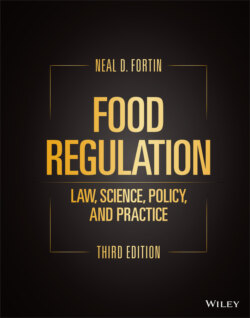Читать книгу Food Regulation - Neal D. Fortin - Страница 18
1.2.3 Evolution of the Food Statutes
ОглавлениеNot long after passage of the Pure Food and Drug Act, legislative battles began to expand and strengthen the law. For instance, the act did not prohibit false therapeutic claims, but only false and misleading statements about the ingredients or identity of a drug. Therefore, the Food and Drug Administration (FDA) could take no action against snake oil with an illegitimate claim to cure cancer so long as the product actually was oil from snakes. In addition, leaders in the food industry called for more stringent product quality standards to create a level playing field. Members of Congress called for better safety standards and fair dealing.
However, major revision of the food law stalled until a precipitous event fell while a significant segment of the public was paying attention. Sulfanilamide, one of the new sulfa drugs, was being used effectively to treat strep throat and other bacterial diseases. To increase the palatability of the bad tasting drug, a drug company mixed the antibiotic with diethylene glycol, a sweet‐tasting liquid. The mixture was called Elixir of Sulfanilamide and shipped in the fall of 1937 (Figure 1.1). Within weeks, deaths were reported to FDA. At least 107 died in an often‐agonizing death. Many of the dead were children who received the elixir for strep throat.14
FIGURE 1.1 Elixir of sulfanilamide.
Source: Image source: FDA.
The manufacturer admitted it had performed no safety tests. None were required. Therefore, the company could not be prosecuted for selling a product with a poisonous ingredient. Ultimately, the company was convicted of misbranding because their product did not meet the definition of “elixir” because diethylene glycol was substituted for alcohol. The company received just a fine, and there was no jail time.
However, the tragedy spurred legislative action, and in 1938, the Food, Drug, and Cosmetic Act (FD&C Act) was enacted. The FD&C Act required premarketing approval and proof of the safety of drugs. The act also:
extended government control to cosmetics and therapeutic devices,
provided that safe tolerances be set for unavoidable poisonous substances in food,
authorized standards of identity, quality, and fill‐of‐container for foods,
authorized factory inspections, and
added court injunctions to the previous penalties of seizures and prosecutions.
